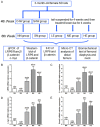The effect of tail suspension and treadmill exercise on LRP6 expression, bone mass and biomechanical properties of hindlimb bones in SD rats
- PMID: 31632553
- PMCID: PMC6789212
The effect of tail suspension and treadmill exercise on LRP6 expression, bone mass and biomechanical properties of hindlimb bones in SD rats
Abstract
Purpose: To investigate whether mechanical load regulates LRP6 expression and whether different intensities of treadmill exercise have different effects on LRP6 expression and the biomechanical properties of hindlimb bones in Sprague-Dawley (SD) rats. Methods: Fifty-six three-month-old virgin female SD rats were randomly divided into seven groups (n=8). Each group was subjected to tail suspension, free physiological activity or different intensities of treadmill exercise according to the experimental design for four or eight weeks. Rats were sacrificed after the intervention based on experimental design, and fresh femurs, tibias and fibulas were harvested for molecular biological analysis, biomechanical testing and micro-CT analysis. Results: LRP6 expression and the Wnt/β-catenin pathway activity decreased, and bone mass and biomechanical properties decreased after loss of mechanical stimulation. For disuse osteoporosis, even physiological activity could improve LRP6 expression, Wnt/β-catenin pathway activity, bone mass and biomechanical properties. Compared with physiological activity, treadmill exercise had better and faster effects on bone recovery. Compared with the Low intensity Exercise Group (LE group), the Medium intensity Exercise Group (ME group) and High intensity Exercise Group (HE group) had higher LRP6 expression, bone mass and biomechanical properties, while there were no significant difference between the ME group and HE group. Conclusions: Mechanical load appears to be a regulator of LRP6 expression, and it further affects the Wnt/β-catenin pathway activity and bone mass. The LRP6 expression, bone mass and biomechanical properties gradually improve as treadmill exercise intensity increases, while there is no significant difference between the ME group and HE group.
Keywords: LRP6; Mechanical load; Wnt/β-catenin pathway; biomechanical property; disuse osteoporosis; treadmill exercise.
AJTR Copyright © 2019.
Conflict of interest statement
None.
Figures






References
-
- Wang H, Wan Y, Tam KF, Ling S, Bai Y, Deng Y, Liu Y, Zhang H, Cheung WH, Qin L, Cheng JC, Leung KS, Li Y. Resistive vibration exercise retards bone loss in weight-bearing skeletons during 60 days bed rest. Osteoporos Int. 2012;23:2169–2178. - PubMed
-
- Garland DE, Adkins RH, Stewart CA, Ashford R, Vigil D. Regional osteoporosis in women who have a complete spinal cord injury. J Bone Joint Surg Am. 2001;83:1195–1200. - PubMed
-
- Cappellesso R, Nicole L, Guido A, Pizzol D. Spaceflight osteoporosis: current state and future perspective. Endocr Regul. 2015;49:231–239. - PubMed
-
- Yuan Y, Chen X, Zhang L, Wu J, Guo J, Zou D, Chen B, Sun Z, Shen C, Zou J. The roles of exercise in bone remodeling and in prevention and treatment of osteoporosis. Prog Biophys Mol Biol. 2016;122:122–130. - PubMed
LinkOut - more resources
Full Text Sources
